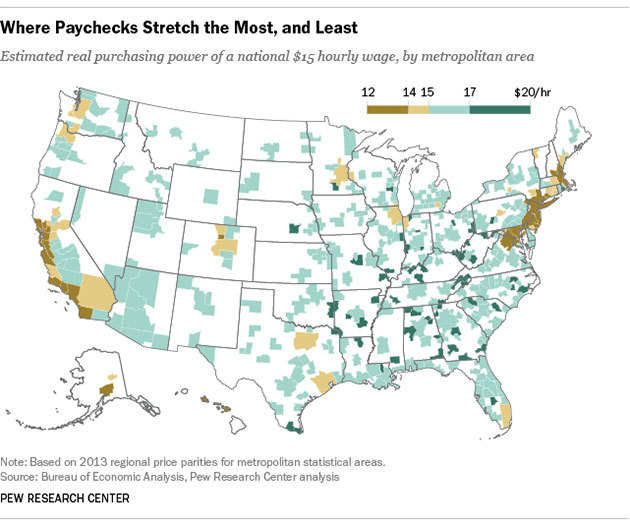The real value of a $15 minimum wage depends on where you live

By Drew DeSilver
The movement for a $15-an-hour minimum wage has scored several high-profile victories lately. New York state plans to phase in a $15 minimum wage for fast-food workers over the next few years. Los Angeles County will raise its minimum to $15 for all workers by 2021, following a similar move by the city of Los Angeles. Seattle is phasing in the $15 minimum that was adopted last year. And the huge University of California system will raise the minimum wage for its workers to $15 by 2017.
While Americans generally support higher minimum wages – a Pew Research Center survey in January 2014, for instance, found 73% in favor of a then-current proposal to raise the federal minimum from $7.25 to $10.10 an hour – wide disparities in local living costs, familiar to anyone who’s relocated for a career, create practical complications. For example, a national $15 minimum would yield $17.08 worth of purchasing power in Macon, Georgia, but only $12.26 in New York City, once the differing price levels in the two cities are taken into account.
We arrived at those estimates by using data on “regional price parities,” or RPPs, for the nation’s 381 metropolitan statistical areas. The RPPs, developed by the federal Bureau of Economic Analysis, measure the difference in local price levels of goods and services across the country, relative to the overall national price level (set equal to 100). So on average, prices in the New York metro area, which has an RPP of 122.3, are 22.3% higher than the nationwide average, while in Macon (RPP of 87.8) prices are 12.2% below average. (Not coincidentally, the push for a $15 minimum wage has been particularly strong in expensive urban areas on both coasts.)
Honolulu is the most expensive metro area in the U.S. – a $15 national minimum wage would have a real purchasing power of $12.24 there. Beckley, West Virginia, has the lowest RPP of any metro area in the nation, so a $15 minimum would have the purchasing power of $19.23 there. (Allentown, Pennsylvania, incidentally, has an RPP of exactly 100, making it the only metro area where $15 really would mean $15.)
If the goal were to guarantee low-paid workers everywhere in the country the same real purchasing power, that would require hundreds of different minimum wages, scaled to each locality’s cost of living. For example, giving everyone the same purchasing power that $15 has in New York City would cost $13.07 in Chicago; $12 in Fresno, California; $11.10 in Cincinnati; and just $10.43 in Anniston, Alabama.
Although the federal minimum wage has been $7.25 an hour since 2009, 29 states and the District of Columbia have enacted their own, higher minimums, according to the National Conference of State Legislatures – including all but two (New Hampshire and Virginia) of the 15 states with above-average RPPs.
But while state-level minimums can address cost-of-living disparities between states, they’re still subject to disparities within individual states, which can be significant. In California, for instance, the priciest metro area (San Jose-Sunnyvale-Santa Clara) is 33.2% more expensive than the least costly (El Centro). The Virginia suburbs of Washington, D.C., are 37.5% more expensive than the Kingsport-Bristol metro area, which straddles the state’s border with Tennessee. And the Chicago metro area is 34.6% more expensive than Danville, Illinois.
[Source]: Pew Research Center


